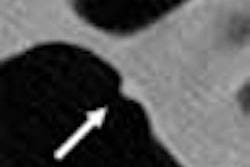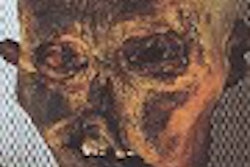SAN FRANCISCO - In the U.S. alone, an estimated 2.7 million CT exams were performed last year on kids 15 years and younger. According to one study, CT accounted for more than 11% of all medical imaging in that age group in 1999, up from just 4% a decade earlier (Journal of Radiology Protection, December 2000, Vol. 20, pp. 345-346).
Yet despite major concerns regarding radiation exposure in children, factors even more powerful seem to be driving CT's growth in the same population. As a result, radiologists have a responsibility to keep up with the latest information and dose-reduction techniques, according to Dr. Lane Donnelly, associate professor of radiology and pediatrics at the University of Cincinnati, and chief of radiology at the Cincinnati Children's Hospital. Donnelly discussed pediatric CT dose reduction at the Society for Pediatric Radiology meeting on Wednesday.
CT use has certainly zoomed ahead at his institution, Donnelly said. A recent study at the pediatric hospital found that between 2001 and 2002 alone, abdominal CT scans had increased by 47% in the emergency department and by 8% in all other outpatient services. Referrals for head CT grew by 29% over the same year.
"The use of CT has become a much more accepted thing in our culture, and in working up patients," Donnelly said. "You can talk probably all day about the reasons for that, but there were multiple factors. We obviously have a problem with malpractice in this country, (and) a big problem is the impatience of the public."
Take a busy family with two working parents and one injured child, Donnelly said. Give them a choice between 12 hours of observation and returning for follow-up -- or an immediate CT scan to look for serious injury -- and CT increasingly wins the vote.
"Most of them are going to demand quicker and more efficient service," he said. And malpractice concerns make doctors increasingly motivated to image suspected trauma injuries before sending patients home. Where CT use in children was once limited to things like malignancies and automobile accidents, it is now used increasingly for problems like abdominal pain, Donnelly said.
Two years have now passed since Dr. David Brenner and colleagues' now-infamous warning that children face a much higher risk of fatal cancers than adults from imaging procedures (American Journal of Roentgenology, February 2001, Vol. 176:2, pp. 289-296).
And more recently, Donnelly said, Dr. Eric Hall from Columbia University concluded that "Individuals exposed 50 years ago to doses comparable to those associated with helical CT today show a small but statistically significant excess incidence of cancer.... An abdominal helical CT scan in a young girl results in a risk of fatal cancer later in life that amounts to about one in a thousand" (Pediatric Radiology, October 2002, Vol. 32:10, pp. 700-706).
At the same time, Dr. Bernard Cohen and others have recently concluded that radiation doses below 25 mSv are probably not harmful, and lower levels may even be beneficial (AJR, November 2002, Vol. 179:5, pp. 1137-1143).
Through all the controversy, what we do know is that the risk of cancer seems to be present at doses lower than previously believed, Donnelly said.
"With non-adjusted pediatric CTs, or CTs obtained with multiple acquisitions during the same study, or multiple CT scans on the same child, it's easy to get up to (a dose) where there is a non-arguable risk of cancer. We also know that children are way more radiosensitive than adults, and that overutilization of CT is a problem. So with all those things in mind, I think it is important to adjust your parameters to decrease dose."
Established methods of accomplishing this include lowering tube current, using thinner collimation and thicker slice reconstructions, increasing table speed and gantry rotation speed, and using a weight-based tube current or mAs.
For example, he said, when using a weight-based system for abdominal scans (developed by Donnelly, Dr. Donald Frush, and colleagues), mAs for an abdominal scan of a child weighing 10-19 lb would be set at 60 mAs, and at 70 mAs for child weighing 20-39 lb (AJR, February 2001, Vol. 176, pp. 303-306). The article contains single-slice CT recommendations, while an upcoming paper will include multislice CT weight tables.
As for kVp, the standard for pediatric radiology is 120, he said. Unlike in radiography, increasing kVp in CT increases the dose, and an increase from 120 to 130 kVp can double the dose to the patient.
Lowering mAs increases noise, but noisy images are still acceptable for many applications, he said. As in adult CT, it's important to tailor the dose to the clinical question. When noise isn't an issue, mAs can often be lowered even below the suggestions in the weight tables.
"Particularly for lung work, you can get very low (mAs) and still have very high-quality images," Donnelly said. In other cases, such as looking for fungal disease in bone-marrow transplant patients, noise dose matters and mAs might need to be higher.
Other common-sense items include exposing only the area that needs to be exposed, avoiding radiosensitive areas such as the gonads, eyes, breasts, and thyroid glands.
The growth of multislice CT makes exposure all the more critical, since unadjusted scan parameters can result in exponentially higher radiation doses, Donnelly said.
Another innovation, in-plane bismuth-coated shielding products, are now available for the eyes, thyroid, breasts, and other sensitive areas, Donnelly said. They are used successfully at his institution, reducing radiation exposure to specific areas, while allowing the penetration of enough radiation to generate an image.
"We use a two-ply system, and we put them on a foam pad ... to give these shields some substance so you can actually work with them, and ... to lift the bismuth up off the patient so that the scatter from the bismuth shield doesn't enter the patient."
Both quantitatively and qualitatively, Donnelly's group found no perceptible differences in the images generated using the shields, which reduced the dose in a phantom by 30% (AJR, February 2003, Vol. 180:2, pp. 407-411).
However, the shields should never be used with automatic exposure controls, as the automated scanner would increase the tube current in response to decreased attenuation, increasing the radiation dose. Scanner manufacturers are currently introducing the first scanners with automated exposure controls; the first papers should be available by the end of 2003.
Vendors are also working to improve the geometric efficiency of multidetector-row scanners (and reduce the so-called "penumbra effect"), he said. Also in development are image filtration improvements and cardiac gating.
Finally, noise simulation software is being developed to eliminate the need for multiple scans. Donnelly, Frush, and colleagues wrote yet another paper on the performance of a simulator package in multidetector-row CT abdominal scans of children (AJR, November 2002, Vol. 179:5, pp. 1107-1113).
Using such programs can eliminate ethical questions surrounding multiple patient scans by simulating the amount of acceptable noise for a given exam in a laboratory setting rather than in the patient.
"CT is an incredibly valuable tool for evaluating pediatric diseases, and certainly the benefits far outweigh the risks," Donnelly said. "But I think that the best way to reduce dose is by controlling inappropriate referrals, and I think that's our biggest battle." At some point an adult who was scanned as a child will get cancer, he predicted, and radiation exposure will move to the legal battleground.
By Eric Barnes
AuntMinnie.com staff writer
May 8, 2003
Related Reading
Limited fetal risk seen in uroradiological procedures on pregnant patients, May 1, 2003
Radiation hormesis and the radiologic imperative, March 21, 2003
U.S. to evaluate whether x-rays should be labeled carcinogens, February 18, 2003
Studies cast doubt on low-level radiation dangers, January 30, 2003
Worrisome radiation dose seen in CT lung screening, follow-up, December 23, 2002
Copyright © 2003 AuntMinnie.com



















